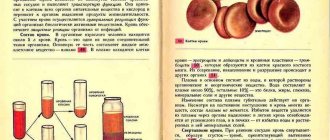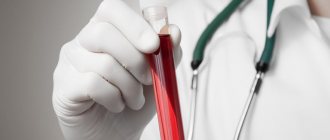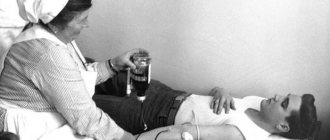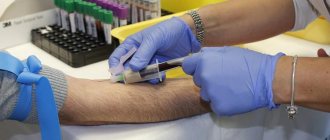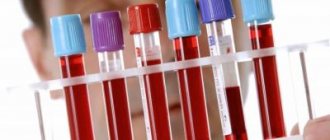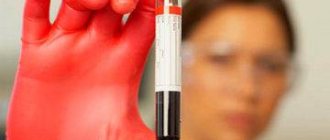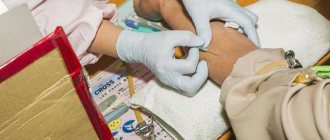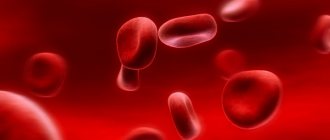Differences between human populations by blood type on Igor Garshin’s website
Home
| Write |
Home > Natural history > Anthropology > Human populations > Human blood groups
Alphabetical list of pages: | | | | | E (Yo) | | | | | | | | | | | | | | | | | | | | | | | | 0-9 | AZ (English)
Human blood plasma may contain agglutinins
α and β, in erythrocytes -
agglutinogens
A and B. Moreover, of the proteins A and α, only one is contained, the same is true for proteins B and β. Thus, there are 4 valid combinations (blood types):
- α and β - I (0)
- A and β - II (A)
- α and B - III (B)
- A and B - IV (AB)
By the way, scientists have discovered dozens of other blood types, such as the Duffy blood type
, which can determine your susceptibility to malaria.
Or blood type Hh
, which, for example, has 1 in 10,000 people in India. (Source - https://zen.yandex.ru/media/different_angle/gruppy-krovi—zagadka-20-millionov-let-5d2f285e8600e100ac743b74)
Sections of the page about human blood types :
- Geography of blood group distribution
- Blood groups of the peoples of the Earth
- Features of a person according to his blood type
- Articles about human blood groups and their appearance
What does blood type mean?
This specific combination of innate antigenic properties of red blood cells in blood cells, and antibodies to them in plasma, refers to the individual characteristics of a person. When transfused, they determine compatibility. In addition, blood type affects the bearing and birth of healthy offspring. It is divided into types depending on the content of antigens in the composition.
Who discovered blood groups? Few people know that they were “rediscovered” several times. Experiments with blood transfusions have been carried out for hundreds of years. Antibodies in the blood were first discovered by Karl Landsteiner. 30 years later he was awarded the Nobel Prize “for the discovery of human blood groups.”
The researcher first announced his observations in 1901. However, his discovery did not create the desired sensation in the scientific community. Six years of discoveries by different scientists brought confusion to the nomenclature. The problem was solved in 1907. The Czech discoverer Jan Jansky assigned numbers to blood groups - I, II, III and IV.
Transfusion compatibility
To determine compatibility, there are individual tests that make it clear that in the body, or more precisely in the blood, there are no antibodies against the donor that begin to fight red blood cells.
The test that is carried out in this case:
At room temperature, a test is carried out on a plane
You need to apply a couple of drops of the recipient's serum to the tablet (2-3 will be enough) and add some red blood cells, the ratio should be (1:10). Then they need to be mixed and observed for 5 minutes for the reaction to take place.
Next, you need to add a few drops of saline, which will help remove nonspecific agglutination.
If after such operations no agglutination is found on the plate, then the blood is completely compatible by group, thanks to aglutinogens.
Another compatibility test with the addition of 33% polyglucin
It is worth putting a few drops of the recipient's serum into the test tube (2 are enough), as well as 1 drop of red blood cells and 1 polyglucin.
The test tube must be rotated in your fingers for at least three minutes, and then you should add 3 ml. physiological solution. After this filling, the test tube must be inverted, but be sure to ensure that the contents are not shaken.
Then look at the light, if there is no agglutination in the cup, then the blood is compatible.
10% gelatin for compatibility testing
You need to mix the following ingredients in a test tube:
- 1 drop of donor red blood cells;
- 2 drops of recipient serum;
- 2 drops of gelatin.
Shake the test tube and place it in a water bath for about 15 minutes. A thermostat is also suitable, but the time there needs to be increased much (30 minutes).
As for the temperature, it should be between 46-48 degrees.
After time has passed, you need to add a new liquid to the test tube - saline solution 5 ml and turn it over.
In the same way, the test tube is placed in the light and viewed. If there is no agglutination, then the blood can be combined.
What are the mistakes in determining blood group compatibility:
- Reagents are not positioned correctly;
- The temperature doesn't quite match. The temperature must be at least 15 degrees. At this temperature, a false trace of agglutination may appear, which will disappear after you add saline;
- Agglutination may not be noticed if there is an error in the reagents and red blood cells;
- They did not take the full time to observe the test tube and its contents;
- It is difficult to determine the patient's blood. This will require an individual approach to blood selection.
- For example, a biological sample.
Before transfusion, it is necessary to remove the container with the transfusion medium from the refrigerator and keep it at room temperature for 30 minutes. Warming in a water bath is allowed, but only in extreme cases. The temperature should be within 37°C. Other instruments are also suitable that will help heat the blood using special devices.
The technique for carrying out this so-called analysis is as follows:
It is necessary to pour 10 ml. transfusion medium, the speed should be 40-60 drops per minute, then the transfusion should be stopped for three minutes;
During these three minutes you need to observe the recipient. What is your condition, breathing, skin color, pulse, pressure and temperature;
This test can be carried out three times;
If symptoms of chills, lower back pain, fever, fever, headache and nausea appear, then you should immediately stop transfusing such contents.
How many types of blood types
"AB0" is not the only system for distributing human liquid tissue. Therefore, how many blood groups exist in the world is unknown. There are about 30 varieties that have been scientifically confirmed. In the post-Soviet space, a classifier is used that was invented by the Czech scientist Jan Jansky. Human liquid tissue is divided into the following groups depending on the presence of antigens on the surface of red blood cells:
- I (0) – no antigens present;
- II (A) – has antigen A present;
- III (B) – antigen B;
- IV (AB) – antigens A and B are present.
Rh factor (Rh)
If we talk about the “Rh” system, then there are two of them – positive (Rh(+)) and negative (Rh(-)). The Rh factor is influenced by the presence of a special protein in the membranes of red blood cells. If it is present, then the Rh factor is positive.
Blood type and Rh factor directly affect the patient's health during transfusion. It is prohibited to transfuse plasma with different Rhesus values. This can be fatal. The first and fourth blood groups are universal for transfusion. But each of them is suitable only for itself.
Who should donate blood?
Medical sources say that it is always preferable to transfuse a person with blood of the exact group of which he is a carrier. Therefore, it is very important that blood banks have all types of blood.
The main rule of blood transfusion is that people with positive blood can be given negative blood. If done the other way around, the person who needs the transfusion will die. This is due to the biological characteristics of the antigen-antibody system.
Although type 1 is considered rare, its uniqueness lies in the fact that in emergency cases such people can be transfused with blood of any type, provided that the Rh factors are compatible. At the same time, other types of blood are not so universal.
Group AB can only be transfused to people with the same blood type.
No matter what kind of blood you have, by donating it you will help save a person’s life. The most expensive and sought after blood is Rh negative. If you are one of the 15% of people who carry it, be sure to think about the possibility of becoming a donor. Periodic blood donation is not only charity, but also a way to improve the functional state of your hematopoietic system.
Where does blood type indicate?
Typically, a person's blood type is shown on their passport. This is very important during an emergency transfusion. For example, in Bashkiria there is a blood transfusion center, which receives about 500 donors daily.
On which page is the data stamp placed? It depends on the country in which the person lives. In Russia, the imprint is made on page 18 (Government Decree No. 828 of 07/08/1997). The blood type must also be indicated on the military ID.
We recommend our news
An art object “Sundial” was installed in Livny
In Livny, in the Slavic Garden park, on October 15, a new art object was opened - “Sundial”.
It appeared with funds from a presidential grant, which was won by a public organization of volunteers... 10/17/2021 17:00 Social news
In the Oryol region, the grain harvest will be one million tons less than last year
To date, grains and leguminous crops have been threshed in the Oryol region on an area of more than 783 thousand hectares (88% of the plan).
3 million 150 thousand tons of grain were threshed with a yield of about 40 ... 10/11/2021 15:50 Social news
Does blood type change?
You can often hear the question, does blood type change throughout life? No, even after the transfusion. However, there are times when temporary changes may occur in the body due to certain types of diseases (for example, cancer) or increased production of red cells in the body. Another reason could be a medical error during the analysis.
Blood group statistics allow 1% of blood group changes among Europeans. This is due to the presence of a weakly positive Rh factor, which, depending on the collection period, shows different results.
How does distribution occur in the world?
Positive blood type is present in 85% of the world's population. Accordingly, the remaining 15% of the world's inhabitants have a negative blood type. About 1% of the Russian population has 4-. However, according to statistics, the most common blood type in Russia is the second:
How to determine blood type? You need to contact a medical laboratory. Specialists will determine BG and Rh factor. Such analyzes can be carried out in private laboratories such as Invitro. The result will be ready after 2 hours. The cost of the service is 500 rubles.
Before taking the test, you should consult your doctor about taking medications. Whether to donate blood on an empty stomach or not is a personal matter; it will not affect the result. It is impossible to find out HA at home.
The rarest blood group is IV. It is inherited by a child in 50% of cases from his parents. An important aspect during pregnancy is the value of the Rh factor of both parents. In women during pregnancy with Rh(-), in most cases, antibodies are produced to foreign proteins of the fetus with Rh(+), which leads to miscarriage. To exclude such a situation, doctors direct the expectant mother to take a blood type test.
The compatibility of the indicators of a man and a woman directly affects the conception of a child. How conception will proceed based on blood type can be seen in the table:
Inheritance of a child's blood type when parents are united with GCs II and III is unpredictable. There is also an exception called the Bombay phenomenon. Its essence lies in the presence of agglutinogens that are absent in the parents. The statistics of people by blood type with this phenomenon is 0.0004% of the planet's population.
There is an opinion that the blood type of the parents allows one to determine the future gender of the child. However, science refutes this. The birth of a girl or boy is influenced only by the chromosome set of the sperm that fertilized the egg. Which blood types are incompatible for conceiving a child? :
| Mother's/father's blood type | 1 | 2 | 3 | 4 |
| 1 | + | X | X | X |
| 2 | + | + | X | X |
| 3 | + | X | + | X |
| 4 | + | + | + | + |
It is difficult to predict the inheritance of the Rh factor in a child. This can be done with 100% confidence if both parents are Rh (-). The blood type of twins may or may not be the same. This factor is influenced by the division of the zygote, when two children are produced from one egg. In this case, the Civil Code will be the same. If the children are fraternal, the probability of a match will be 20%.
You can find out what predisposition your child will have by performing the appropriate calculation on an online calculator. Young couples often use the service to conceive. However, only doctors can determine a 100% match.
April 2017
Return to issue >>
Tags: science, medicine
From anatomy lessons we remember that the blood of all people is divided into eight main types - the first, second, third and fourth groups according to the AB0 system, also labeled 0, A, B and AB, each of which, in turn, may have a positive or negative Rh factor. However, in fact, scientists currently know at least 35 different variations. And the individual composition of blood is actually much more complex than non-specialists think. So what will the recently discovered rare subtypes of blood turn out to be - a mortal danger for their carriers or a panacea for all humanity?
Vital fluid
Blood has not yet been fully studied, and large-scale research continues daily. However, the first discoveries in hematology were made quite a long time ago. Karl Landsteiner identified 4 blood groups back in 1901, observing how the blood of different donors coagulates when mixed. From his findings, a classification system was formed based on the content of special agglutinogens A, B or their absence in red blood cells - erythrocytes - 0. Thus, group I is distinguished, in which erythrocytes do not contain agglutinogens (according to the AB0 system - 0), group II , containing agglutinogen A (labeling A according to the AB0 system), group III with agglutinogen B and, finally, group IV, which contains agglutinogens A and B. This system, of course, is not unique, and there are at least 33 more blood classification systems , recognized by the International Medical Society. However, the method of blood separation proposed by Karl Landsteiner is to this day the most generally accepted and convenient, so it is used everywhere, leaving the remaining classifications to scientists and specialists.
Blood type 1 is without a doubt the most common blood type around the globe, with about 43% of the world's population having it. Blood of the second group is most often found among Europeans, and flows in the veins of 35% of people. The third group is already much rarer, and only 16% of people can boast of it. And the fourth group is represented in only 6% of the planet's population.
It is believed that blood groups did not appear in humanity all at once, but gradually, during the course of evolution. And at first everyone on Earth had one common blood type - first. It is characteristic of a species that was primarily engaged in hunting. But gradually, as a result of mutations and due to changes in lifestyle, others appeared. According to many scientists, this is primarily due to changes in diet. According to this theory, the second group formed when people stopped eating raw meat and began to eat greens, roots, fruits and vegetables. The third appeared during the transition to domesticity, when humanity began to eat milk and meat from livestock. And the fourth, youngest group, appeared about 1000 years ago as a result of the mixing of the second and third groups.
In addition, human blood can have a positive and negative Rh factor, depending on whether antigens A and B are present on the surface of red blood cells or not. More than 85% of Caucasians have a positive Rh factor; among representatives of the Negroid race, Rh-positive blood is found in more than 93% of cases, and among Mongoloids such people are more than 99%.
People realized the importance of this division of blood into groups and determining its Rh factor only when transfusion medicine became widespread, or, more simply, doctors increasingly began to resort to transfusions of blood from one person to another. It is worth understanding that the blood group and its Rh factor indicate that the red blood cells of a particular person contain a certain set of agglutinogens and antigens. And the discrepancy between these molecules in the blood of the donor and recipient can cause an acute immune reaction in the latter, in which the body will reject the received blood or will not tolerate the procedure at all. This is why it is so important to know everything about the red blood cells of the donor and the patient during any blood transfusion operation.
So, according to Landsteiner’s classification, people with blood group I are ideal donors; it is believed that their blood can be transfused to any other person. And people with group IV, in turn, can be considered as universal recipients, and they can be transfused with any other blood.
But is everything as simple as it seems at first glance? And what about rare and little-studied blood groups?
Rare blood type
For a long time it was believed that the rarest blood type in the world is the fourth. And it is not surprising, because it appeared much later than the others and had not yet spread widely enough. Well, if we consider only well-known groups, then the fourth, of course, can easily lay claim to the title of the rarest and least common; its carriers are only 6% of the world's population. And if we consider the subtype of this blood group with a negative Rh factor, then it is even much rarer - on Earth only 0.4% of people can boast that such blood flows in their veins.
However, it is unevenly distributed throughout the world. In some countries, such as Turkey, Israel, Finland or Poland, the prevalence of this group is around 7% or even more, but in China there are only 0.05% of the population with such blood. Of course, this cannot but be a problem.
After all, although people with the fourth group are considered ideal patients for blood transfusion and, according to the general belief, they can safely be infused with blood from the other three groups, the negative Rh factor allows them to accept donor blood from only 11% of the population with a similar Rh factor. And if in the aforementioned Israel or Finland this is a little easier to do, then for China, where the number of people with a negative Rh factor fluctuates around 1%, finding a suitable donor is a truly difficult task.
But despite this problem, carriers of the fourth blood group also have undeniable advantages. They have a more flexible and strong immune system than all other inhabitants of the earth. According to scientists, this is a consequence of the fact that this group appeared due to the unfavorable influence of the external environment, when nature itself decided to mix the second and third blood groups to obtain a new, more perfect and resistant to poor living conditions. Formed just 1000 years ago as a result of the mixing of Mongoloids and Indo-Europeans, the new blood immediately received two sets of antigens - from the second and third groups, and with them all the immune advantages. In addition, it is believed that the neural networks of carriers of the fourth blood group work a little faster than those of other representatives of humanity.
"Golden" blood
And yet, today, perhaps the most rare and unusual blood is that with a zero Rh factor, or Rh-0. As you can guess from the name, such blood does not contain Rh antigens at all. However, it should not be confused with a negative Rh factor, because people with so-called “negative” blood do not only have the Rh-A or Rh-B antigen. But in the rarest “golden” blood there are absolutely no Rh antigens. This is so unusual that over the past 50 years, only 40 people have been discovered on our planet whose blood has a zero Rh factor.
What makes this fact so interesting for doctors and scientists? First of all, such blood is much superior to blood of type 0, or group 1, as a universal one for transfusion. Rh-0 is compatible with almost any other blood type and never causes rejection. The thing is that during a transfusion, our body, as an immune response, can refuse someone else's blood, which contains antigens that are unusual for it. And Rh-0 blood, having not only the well-known antigens A or B, but also no other antigens at all, is absolutely safe. In addition, the zero Rh factor provides its carriers with higher blood clotting and provides a kind of insurance against the development of coronary heart disease.
But, to the deep regret of doctors, at the moment only 9 owners of “golden” blood around the world regularly donate blood. It is not surprising that these invaluable reserves are used only in the most extreme and dire cases. And every time such a donor package literally allows us to pull the patient out of the other world. That is why doctors call such blood “golden” - sometimes it is truly worth its weight in gold.
After discovering a unique blood type, scientists immediately began studying it and, understandably, trying to synthesize blood with a zero Rh factor in the laboratory. Not long ago they made significant progress in this field. To begin with, a group of specialists managed to discover a special enzyme in one of the types of coffee beans, which is capable of completely removing the B antigen from red blood cells under certain conditions. True, it has not yet been possible to fully understand the principles of the enzyme’s operation and obtain a stable result, and how to remove antigen A from blood cells in this case is also still unknown.
At the same time, in another laboratory, two bacteria were artificially bred. The enzyme of one of them removes antigen A from blood cells, and the other removes antigen B. The work of these microorganisms has been repeatedly studied in laboratory conditions, scientists have carried out all the necessary tests and are now ready for experiments with living people in real conditions. This method of artificially creating a zero Rh factor is the most effective and safe, so the United States is already developing a special device that will effectively and efficiently convert the blood of any donor into Rh-0 blood directly in the laboratory of every hospital. Even if the purification process is only 100 ml and takes about 28 hours, it is still worth it, because the resulting blood is ideal for absolutely any recipient.
Thus, the issue of correct selection of donor blood will very soon not be as pressing as it is now. In addition, blood transfusions with a zero Rh factor can also help patients recovering from operations to transplant foreign internal organs, and prevent tissue rejection and necrosis. To begin with, the new technology is planned to be introduced into circulation in several large medical centers in the United States.
Bombay phenomenon
No less rare is blood, which scientists call the “Bombay phenomenon”, or simply “Bombay”. It was first discovered in a resident of the city of Mumbai, formerly called Bombay, in India in 1952. And it is in India that there are the most carriers of such blood: the number of its owners is about 0.01% of the total population of the country. In the rest of the world, this figure is much lower - only 0.0001%.
The peculiarity of Bombay blood is that its plasma contains as many as three types of agglutinogens - not only A and B, as in the first group, but also a unique and less common agglutinogen H. This was discovered during one of the malaria outbreaks, when many residents of India They took blood for analysis. It was then that a new, previously unknown agglutinogen was found in only one blood sampling point from three people at once. Additional studies made scientists understand that it is closely related in nature to the already known agglutinogens A and B. It arose, apparently, as a result of a small genetic deviation due to numerous consanguineous marriages, which are not uncommon in India.
What is special about people with Bombay blood? Scientists believe that the additional agglutinogen at least contributes to increased adaptability and resistance of the body, and that people with such blood suffer less from excess weight and cholesterol deposits than others. However, it is not without its drawbacks, because carriers of the Bombay phenomenon can only be transfused with the same blood as theirs - with the indispensable presence of agglutinogen H, while they themselves, like people with the first blood group, are almost ideal donors.
Deadly subspecies
The history of studying another rare subtype of blood began back in 1952, when a routine blood transfusion was performed in New York on a 66-year-old woman suffering from colon cancer. The operation was successful, but soon her body reacted very sharply to the injected blood and flatly rejected it, which almost led to the death of the patient. Fortunately, the patient, later called “Patient Vel” in medical articles, was saved, and doctors took all the necessary tests from her. So it turned out that the woman’s body produced such a powerful immune response to some as yet unknown protein compound found in the donor’s red blood cells. Having checked the presence of such a protein in the blood of other people, scientists soon came to the conclusion that most people on the planet have this unexplored protein in their blood, so blood without such a protein in red blood cells began to be named after the same 66-year-old American Vel-negative . It was found that any blood transfusion containing the newly discovered protein to people who did not have it could be lethal for them.
For a long time, technical capabilities did not allow the study of the protein itself, so scientists studied the newly discovered blood group almost by simple brute force. It was only in 2013 that the mysterious substance was finally studied in France. The tiny, previously unknown blood molecules are called integral membrane proteins 1, or SMIM1 for short.
So, it is now known that although the majority of people in the world are Vel-positive, there are about 400 thousand people who have a Vel-negative blood type. More than 200 thousand such people were found in Europe and more than 100 thousand in North America. About 100 thousand more live in different cities and countries around the world. It's scary to think, but for one in 2,500 people in Europe, even the smallest blood transfusion can lead to acute kidney failure if the recipient's blood does not contain SMIM1.
And Vel-negative blood remains extremely difficult to find for transfusion. Firstly, this is due to the fact that there are very few speakers there. In addition, this new blood type is not yet universally determined, and separate tests must be performed to detect the presence of SMIM1 in a patient. And for this you need a specialized laboratory. So in most hospitals around the world, Vel-negative patients are identified by injecting potential carriers of Vel-negative blood with tiny amounts of Vel-positive blood and carefully watching for rejection.
Fortunately, just recently scientists were able to find out which DNA section is responsible for the presence or absence of SMIM1 in human blood. And soon a special DNA test was developed, which made it possible to identify Vel-negative patients much more accurately, easily and safely. This test takes just two hours and, when implemented widely, could save many lives.
In addition, scientists are currently working on antibodies that will be able to neutralize SMIM1 in the blood of donors and thus allow Vel-negative patients to receive blood during transfusion without health consequences. It’s too early to talk about the results, but we can hope that such a serum will finally help make the much more common Vel-positive blood safe for transfusion to any patient.
Rare blood proteins
In the last decade, blood testing technology has experienced a major qualitative leap. As a result, in 2012, specialists from the University of Vermont managed to discover two more new blood subgroups, named Langereis and Junior - after the names of the people in whom they were first discovered. These new blood subtypes were identified by isolating special proteins on the surface of the carriers’ red blood cells – ABCB6 and ABCG2. In addition, scientists predict the imminent discovery of at least a dozen more as yet unknown proteins of a similar structure, and, consequently, a dozen new subtypes of human blood.
Scientists are trying to quickly sort out this issue, because, as in the case of the Vel-negative patient, for carriers of rare proteins, even a small transfusion of foreign blood can become an extremely complex and deadly procedure. At the same time, it is not yet possible to identify the presence of an unusual protein in advance without conducting a series of lengthy and expensive tests, and quickly finding suitable donors may not be so easy. By the way, organ transplantation for people with Langereis and Junior blood groups may be useless, because there is a high probability of donor tissue rejection due to the same ABCB6 and ABCG2 proteins.
Fortunately, scientists have been able to trace a certain pattern in the distribution of unique blood types across the Earth. They found that rare groups are found predominantly in certain relatively closed ethnic groups. Thus, in Japan there are about 2,500 people with the Langereis blood type. And although people with such a group are found all over the world, their total number is not so large. Also in Japan, about 50 thousand carriers of the Junior blood type have been discovered, and this same blood type is quite common in the European gypsy community. Knowing this, scientists propose to conduct tests to detect the ABCB6 and ABCG2 proteins before blood transfusion operations, at least among these population groups.
One of a kind
Some blood types are common throughout the globe, others are extremely rare, and their carriers number only in the hundreds or dozens. But there is also the rarest blood group in the world, the owner of which is only one person on Earth.
His name is James Harrison, and his amazing feature is easy to explain. The thing is that when James was only 13 years old, he had to undergo a complex surgical operation, during which he almost died from loss of blood. Fortunately, he survived and the transfusion given to him during the 16-hour operation was successful. However, during the entire operation, in order to save his life, doctors passed more than 13 liters of donor blood through his body. It is worth noting that in a critical situation they did not pay special attention to what kind of blood was transfused to the boy; it was more important for them to save his life - and a variety of donor packages were used, regardless of group and Rh factor.
So, Harrison successfully underwent the operation, no rejection of the transfused blood occurred, and he safely lived to be 18 years old. From this age you can become a voluntary donor, so James, wanting to repay the debt, turned to the Red Cross point. Of course, before taking blood, doctors carried out all the necessary tests. It was then that it turned out that James’ blood was amazing and unique of its kind. After transfusions of different blood types, which his body accepted and processed for itself, Harrison began to produce special antibodies that helped prevent Rh conflicts. Thanks to these antibodies, it was possible, for example, to help a pregnant woman bear a child with a Rh factor different from her own. The introduction of even a small amount of antibodies obtained from James' blood was guaranteed to help avoid jaundice and anemia of the fetus and even stillbirth.
So when doctors explained to Harrison how unique and important his blood type was, he asked just one question: “How often can you donate blood?” And since then, for more than 60 years in a row, every 3 weeks James Harrison has been at the blood donation collection point. Over the past time, more than 377 liters have been taken from him, and this is bearing fruit - only thanks to him, 2 million women across the planet were prevented from having Rh conflict with the fetus, and this, according to statistics, is more than a million lives saved - both maternal , and children's.
Of course, in addition to the above, there are other rare types of blood that have not yet been so well studied and are currently being studied in the best laboratories in the world. Fortunately, the presence of rare proteins does not in any way affect the daily life or health of their owners, and known difficulties can only arise with blood transfusions. However, even here a way out was found. For people with an identified but not yet fully understood rare blood type, doctors simply suggest donating their own blood in advance and keeping it in reserve in case they ever need a transfusion.
In addition, scientists around the world are working tirelessly to create a universal blood substitute. The final product must meet a number of requirements, for example, it must be easy to synthesize or at least tolerate transportation well, be stored for a long time, and be safe for transfusion to people with any known blood group and Rh factor, taking into account rare blood characteristics. And although scientists have not yet been able to obtain an ideal substitute, they have already developed the first synthetic blood of its kind. True, unlike real human blood, it can so far only perform one, but the most important function - to carry and distribute oxygen throughout the body.
Top
View comments (0)
leave a comment
Leave a comment
Your comment will appear on the page after approval by a moderator.
Country Analytics
Blood group statistics in the world are distributed as follows:
- I – 45%.
- II – 35%.
- III – 13%.
- IV – 7%.
Blood group statistics vary significantly across countries. The rarity of a group depends on the time of its origin. The championship is given to the I Civil Code. Statistics of people by blood group with a negative Rh factor have a smaller percentage of people. Statistics on blood groups and Rh factor around the world are as follows:
According to Wikipedia, the percentage of blood types in the world occurs in mysterious ways. For example, the Peruvian Indians, Bororo and Chomen have - I (100%). Population of Hawaii - II (61%).
Therefore, it is possible to determine nationality by blood group. For the European race it is characteristic – II, for the Negroid race – I. For Asians – III. China has the largest number of people with 3+ among other countries. However, in China, the fewest people have 4-.
Scientists have found that in Ukraine people with blood group II are at greater risk from cancer.
Blood group statistics in the Republic of Belarus show the same number of people between I and II. The country is constantly in need of donors as it carries out complex operations, including organ transplants. In donor centers in Belarus, the components of blood groups are divided into components: red blood cells, platelets, plasma.
It is worth recalling that donors regularly renew their blood in their bodies, which strengthens their immunity.
Is it possible to determine a person's character?
Psychologists say that you can determine a person’s character by their blood type. In Japan, even hiring is based on test results.
People with GC I are natural leaders. They are wonderful organizers. The disadvantage is sudden aggression, which is sometimes groundless.
Holders of II GK have a balanced and calm character. They tend to take everything to heart. They create and maintain home comfort, but due to their stubborn nature they can harm themselves at work and at home.
People with III GC are creative people. They are easy-going, but the routine or monotony of life often plunges them into depression. Hence the inconsistency in actions, dreams, goals.
Holders of the AB group are considered to be gentle people. But they have a wild imagination. They always know how to find a diplomatic solution in a conflict situation. Statistics of blood groups in the Russian Federation show that there are most of these people in the country.
Distribution table in Russia
The distribution and occurrence of various groups of the AB0 system varies among individual peoples, and this is influenced by the frequency of occurrence of phenotypes.
In the Central European population, blood groups were distributed as follows:
- 0 (first) - 43%,
- A (second) - 42%,
- B (third) - 11%,
- AB (fourth) - 4%.
Thus, we can conclude that in Europe the most common is the first group, and the least common are people with the fourth group.
If you move geographically towards eastern countries, you will notice a pattern: agglutinogen A will be found less and less often, but agglutinogen B will become more and more common.
In the Russian Federation, the prevalence of blood groups according to the ABO system can be presented in the form of a table (in percentage):
| First (0) | Second (A) | Third (B) | Fourth (AB) |
| 33% | 38% | 21% | 8% |
That is, in Russia, the majority of citizens are carriers of the second group, but the fourth group still remains the rarest.
Blood group diseases
It is believed that each blood group is predisposed to the following diseases:
| I | Stomach ulcer, gastritis, inflammation of the gallbladder, colitis, infectious diseases. This also includes diseases of the thyroid gland, blood system, skin diseases, rheumatism, allergic rhinitis and asthma. |
| II | Oncology, infections, diabetes, vascular ischemia, heart disease, pneumonia, chronic fatigue syndrome, gastritis and kidney stones |
| III | Parkinson's disease, gastrointestinal oncology, pathology of the cardiovascular system, rheumatism, otitis media, tonsillitis, cystitis, radiculitis and neuroses |
| IV | Colds, infectious diseases, dementia, hypertension, stroke, anemia, sinusitis. This also includes skin diseases, pancreatic and ovarian cancer, neurotic and psychotic reactions, diseases of the musculoskeletal system |
Which blood type is susceptible to coronavirus?
Chinese scientists thoroughly studied the test results of 2,173 patients in the cities of Wuhan and Shenzhen. The remains of 206 people who died from coronavirus were also studied.
The conclusion is clear: among the sick people, most of them are people with group II (they get coronavirus infection 1.2 times more often). Patients with blood group IV died less often. Among healthy people, most people are in group I. They get sick 1.3 times less often.
Research results show that the first blood group is most resistant to coronavirus. You can find out more about coronavirus in another article -.
